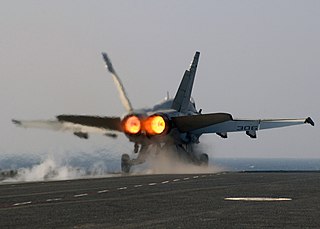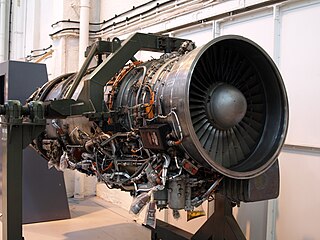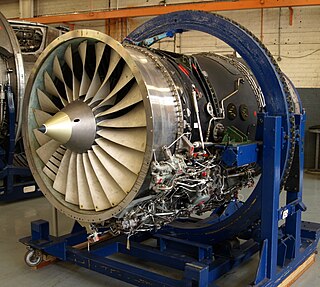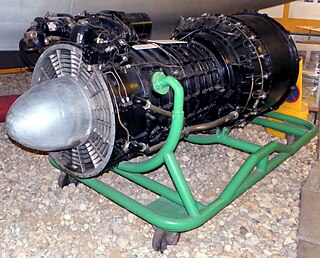
The turbofan or fanjet is a type of airbreathing jet engine that is widely used in aircraft propulsion. The word "turbofan" is a portmanteau of "turbine" and "fan": the turbo portion refers to a gas turbine engine which achieves mechanical energy from combustion, and the fan, a ducted fan that uses the mechanical energy from the gas turbine to accelerate air rearwards. Thus, whereas all the air taken in by a turbojet passes through the combustion chamber and turbines, in a turbofan some of that air bypasses these components. A turbofan thus can be thought of as a turbojet being used to drive a ducted fan, with both of these contributing to the thrust.

An afterburner is an additional combustion component used on some jet engines, mostly those on military supersonic aircraft. Its purpose is to increase thrust, usually for supersonic flight, takeoff, and combat. Afterburning injects additional fuel into a combustor in the jet pipe behind the turbine, "reheating" the exhaust gas. Afterburning significantly increases thrust as an alternative to using a bigger engine with its attendant weight penalty, but at the cost of very high fuel consumption which limits its use to short periods. This aircraft application of reheat contrasts with the meaning and implementation of reheat applicable to gas turbines driving electrical generators and which reduces fuel consumption.

The Rolls-Royce Pegasus, formerly the Bristol Siddeley Pegasus, is a turbofan engine originally designed by Bristol Siddeley. It was manufactured by Rolls-Royce plc. The engine is not only able to power a jet aircraft forward, but also to direct thrust downwards via swivelling nozzles. Lightly loaded aircraft equipped with this engine can manoeuvre like a helicopter. In particular, they can perform vertical takeoffs and landings. In US service, the engine is designated F402.

The Turbo-Union RB199 is a turbofan jet engine designed and built in the early 1970s by Turbo-Union, a joint venture between Rolls-Royce, MTU and Aeritalia. The only production application was the Panavia Tornado.

The Rolls-Royce RB.80 Conway was the first turbofan engine to enter service. Development started at Rolls-Royce in the 1940s, but the design was used only briefly, in the late 1950s and early 1960s, before other turbofan designs replaced it. However, the Conway engine was used in versions of the Handley Page Victor, Vickers VC10, Boeing 707-420 and Douglas DC-8-40. The name "Conway" is the English spelling of the River Conwy, in Wales, in keeping with Rolls' use of river names for gas turbine engines.

The Rolls-Royce RB.183 Tay is a medium-bypass turbofan engine, developed from the RB.183 Mk 555 Spey core and using a fan scaled directly from the Rolls-Royce RB.211-535E4 to produce versions with a bypass ratio of 3.1:1 or greater. The IP compressor and LP turbine were designed using technology from the RB.211 programme. The engine was first run in August 1984. The Tay 650 had a new HP turbine which incorporated new technology which had been proven with the RB.211-535E4. This engine also had a new combustor for improved durability. The Tay family is used on a number of airliners and larger business jets, including the Gulfstream IV family, Fokker 70 and Fokker 100, with a later version being used to re-engine Boeing 727-100s.

The Rolls-Royce Spey is a low-bypass turbofan engine originally designed and manufactured by Rolls-Royce that has been in widespread service for over 40 years. A co-development version of the Spey between Rolls-Royce and Allison in the 1960s is the Allison TF41.

The General Electric TF39 was a high-bypass turbofan engine that was developed to power the Lockheed C-5 Galaxy. The TF39 was the first high-power, high-bypass jet engine developed. The TF39 was further developed into the CF6 series of engines, and formed the basis of the LM2500 marine and industrial gas turbine. On September 7, 2017, the last active C-5A powered with TF39 engines made its final flight to Davis-Monthan Air Force Base for retirement. The TF39 was effectively retired, and all remaining active C-5 Galaxys are now powered by F138 (CF6) engines.

The Metropolitan-Vickers F.2 is an early turbojet engine and the first British design to be based on an axial-flow compressor. It was an extremely advanced design for the era, using a nine-stage axial compressor, annular combustor, and a two-stage turbine.

The Rolls-Royce Trent 900 is a high-bypass turbofan produced by Rolls-Royce plc to power the Airbus A380, competing with the Engine Alliance GP7000. Initially proposed for the Boeing 747-500/600X in July 1996, this first application was later abandoned but it was offered for the A3XX, launched as the A380 in December 2000. It first ran on 18 March 2003, made its maiden flight on 17 May 2004 on an A340 testbed, and was certified by the EASA on 29 October 2004. Producing up to 374 kN (84,000 lbf), the Trent 900 has the three shaft architecture of the Rolls-Royce Trent family with a 2.95 m (116 in) fan. It has a 8.5-8.7:1 bypass ratio and a 37–39:1 overall pressure ratio.

The Allison TF41 is a low-bypass turbofan engine.

The Rolls-Royce RB.401 was a British two-spool business jet engine which Rolls-Royce started to develop in the mid-1970s as a replacement for the Viper. RB.401-06 prototype engines were already being manufactured when a decision to develop the higher thrust RB.401-07 was taken.

The Rolls-Royce/SNECMA M45H was an Anglo-French medium bypass ratio turbofan produced specifically for the twin-engined VFW-Fokker 614 aircraft in the early 1970s.

The Bristol Siddeley BS.100 was a British twin-spool, vectored thrust, turbofan aero engine that first ran in 1960. The engine was designed and built in limited numbers by Bristol Siddeley Engines Limited. The project was cancelled in early 1965.

The VFW VAK 191B was an experimental German vertical take-off and landing (VTOL) strike fighter of the early 1970s. VAK was the abbreviation for Vertikalstartendes Aufklärungs- und Kampfflugzeug. Designed and built by the Vereinigte Flugtechnische Werke (VFW), it was developed with the purpose of eventually serving as a replacement for the Italian Fiat G.91 then in service with the German Air Force. Operationally, it was intended to have been armed with nuclear weapons as a deterrent against aggression from the Soviet Union and, in the event of a major war breaking out, to survive the first wave of attacks by deploying to dispersed locations, rather than conventional airfields, and to retaliate against targets behind enemy lines.

The Rolls-Royce RB.108 was a British jet engine designed in the mid-1950s by Rolls-Royce specifically for use as a VTOL lift engine. It was also used to provide horizontal thrust in the Short SC.1.

The Rolls-Royce RB.162 was a simply constructed and lightweight British turbojet engine produced by Rolls-Royce Limited. Developed in the early 1960s, it was specially designed for use as a lift engine for VTOL aircraft but was also used in a later variant of the Hawker Siddeley Trident airliner as an auxiliary boost engine. A smaller related variant, the RB.181 remained a design project only, as did a turbofan version designated RB.175.

The Rolls-Royce RB.141 Medway was a large low-bypass turbofan engine designed, manufactured and tested in prototype form by Rolls-Royce in the early-1960s. The project was cancelled due to changes in market requirements that also led to the development and production of the smaller but similar Rolls-Royce Spey, and the cancellation of the Armstrong Whitworth AW.681 military transport aircraft project.

The Rolls-Royce RB.145 was a British jet engine designed in the early-1960s by Rolls-Royce for use as a lightweight VTOL lift and cruise engine. Developed from the Rolls-Royce RB108 the RB.145 featured more accessories and a higher thrust rating. Six engines developed by MAN Turbo were fitted to the first prototype of the EWR VJ 101 experimental German fighter aircraft, achieving supersonic flight by July 1964.

The Rolls-Royce RB.203 Trent was a British medium-bypass turbofan engine of around 10,000lb thrust designed for production in the late 1960s, bearing no relation to the earlier Rolls-Royce RB.50 Trent turboprop or the later high-bypass Rolls-Royce Trent turbofan.





















